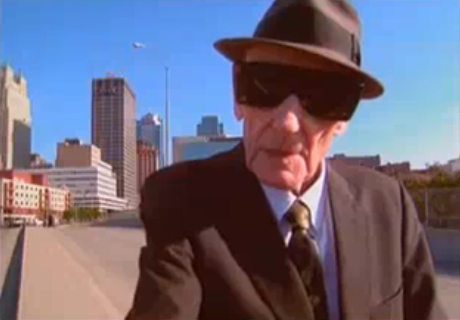
Charles Faris went to interview Robert Anton Wilson for the second issue of High Frontiers. He was the first among us to meet Bob. Here, excerpted from the rough draft in progress of Use Your Hallucinations: MONDO 2000 in the Late 20th Century Cyberculture, are a few brief comments on that event, first from myself and then from Charles.
……………….
R.U. Sirius: We had an interview with Robert Anton Wilson that had been done by Charles Faris for the second issue. I was so excited to hear what Bob was like. He came back and described Bob and his wife Arlen as being, superficially at least, like an old middle class married couple, very gracious and polite, bringing out snacks in little bowls and drinks. This seems like normal civility to me now but I was still in that place where you would probably only offer someone a beer or a joint… maybe a line if you were in a mood. It struck us both as funny, but not in a sneering sort of way. Just outside of our expectations.
Charles Faris: I had read everything Bob Wilson had written. So I had this whole idea about Bob based on his purposeful deliver. And then I get to his apartment and the first thing he does is offer me this bowl of Cheetos. And it was just like, “Wow, here’s Bob. He’s got Cheetos.†It was so normal. It wasn’t like descriptions I’d read of him in Berkeley with the salons and all that.Â
………………
And here are some excerpts from the RAW interview. And, yes, we did that whole e.e. cummings thing, with no capital letters and as a result, my spell checker practically reached out and punched me. Â I predict that after The Singularity, intentional errors will be impossible (and the only eccentricities allowed will be the ones that are pre-embedded.)
Changing Reality Tunnels
Interview by Elizabeth Gips and Charles Faris
my cosmology is the multiple universe model first suggested by irwin schroedinger, the nobel physicist, back in the ’40s, and more recently developed by John archibald wheeler at princeton and bryce dewitt and jack sarfatti and various other physicists. according to this cosmology, everything that can happen does happen.
sirius is to occultists what ufos are to the population at large. contact has been established, of course, everybody knows that. contact has been established with the human collective unconscious. most people have this idea that contact is something that’s going to happen in the future, a flying saucer or a flying pie plate or something will land on the white house lawn and somebody will get out. and the president, because he knows the mason word, will be able to greet them correctly, the president is always a 33° mason, you know, they’ve passed on this word since the first contact 4,500 years ago and as soon as they come out, he’ll say the secret masonic formula, “klaatu baranda nikto” and they’ll know they’ve contacted the right guy and it’ll all be fine. that’s a lot of nonsense. the contact was never intended to be of that form and they’re not interested in primate politics at all. the alpha male in the baboon herd is precisely as important and unimportant to them as the president of the united states or the supreme servant of the people in red china. primate politics is all pretty much the same; chimpanzees, orangutans, baboons, people… higher intelligence isn’t interested in that at all. the contact has been established with the collective unconscious of humanity and everybody knows it. you’ve just got to look at comic books, the covers of rock albums, everywhere you look, it’s all over our culture, we are not alone, as the ads for close encounters say. everybody knows it. it’s the most open secret of the twentieth century.
i was contacted by higher intelligences from sirius with a lot of urgent messages about things i had to get done in the next 25 years which were very important for the evolution of the human species, or that’s the way it seemed to me at the time. later on, i decided it was probably just “the little people,” as the Irish called them, playing a joke on me. then later on I decided it was probably the right hemisphere of my own brain giving me vistas of the future, then later on, I decided it was actually my holy guardian angel, as the cabalists say. then later, i decided that i was just having a schizophrenic breakdown at the time. i haven’t decided yet which one i believe, except that i know a lot of intelligent people who have the experiences and they don’t seem crazy to me. i can’t judge if i’m crazy, ’cause who can judge himself? the one physicist i know who believes it’s all time-travel, and not extraterrestrial, has had contact with time travelers. higher intelligence always fits into your belief system, so that contact will be with something you will believe is real. you can’t be contacted by something you don’t believe is real.
if people can’t change their reality constructs — their imprinted models, their maps and models of reality, they’re going to be increasingly uncomfortable, and Exo-Psychology is the only do-it-yourself manual, so far, that tells you how to rewire your nervous system from the inside out to keep up with incoming signals so you don’t have to screen out new signals and you don’t have to be afraid of them and you can make a new reality map as often as necessary.
discouragement is bad for the nervous system, bad for the glands; it does all kinds of things to the stomach acids… it’s to be avoided at all costs. it lowers the energy level in general. the first thing you got to learn in practical neuropolitics is to stay high all the time. negative energy is just wasted energy.
an energy slave is a machine that’s the equivalent of a human being working for you eight hours a day. that’s a unit that [buckyj fuller worked out based on aristotle’s idea that the moral equivalent of slavery was machinery. aristotle said that we could abolish slavery when we had machines to do those jobs. well, of course, first we abolished chattel slavery and started wage slavery. the next step is to abolish wage slavery. eventually, we’ll be able to turn the work all over to the machines. as a matter of fact, muscle labor is becoming increasingly obsolete and most of the routine forms of mental labor are becoming increasingly obsolete too.
communication is only truly possible between equals. you know you’re unequal when you’re in a situation where you can’t communicate. did you ever try to communicate with a government official? you can’t! because you’re not equal, they have power over you. if you’ve ever been in a marriage where you couldn’t communicate with your mate, that meant that there wasn’t any equality in the relationship. it was authoritarian, so any authoritarian structure — in the family, in corporations, in armies and so on leads to communication jamming and what i call progressive disorientation.
learn how to control your own nervous system and the whole universe is yours. this is the goal of the philosophers, in alchemical terms, when you learn to turn all incoming impressions to your advantage, then you’re the richest person on the planet, everything turns to gold. that’s the transmutation the alchemists were working for.










